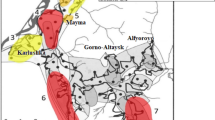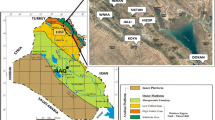More than half of the dose from all natural sources of radiation is created by radon and its daughter decay products. The radon hazard of a building site is evaluated by measuring the radon flux density. Some researchers involved in radon measurements are now of the opinion that the amount of radon released from the surface is determined by the type of rock. However, radon release from the surfaces of various types of rocks is sparsely studied. This article reports the results of radon flux density measurements performed on the surface of common rocks. Attention is focused mainly on the most typical sedimentary rocks found in populated areas.
Similar content being viewed by others
References
H. Alonso and J. Rubiano, “Assessment of radon risk areas in the Eastern Canary Islands using soil radon gas concentration and gas permeability of soils,” Sci. Total Environ., 664, 449–460 (2019).
P. S. Miklyaev, V. I. Makarov, A. L. Dorozhko, et al., “Radon fi eld of Moscow,” Geoekol. Inzh. Geoekol. Gidroekol. Geokriol., No. 2, 172–187 (2013).
M. Neznal and M. Neznal, “The new method for assessing the radon risk of building sites,” Czech Geol. Survey, 16, 7–47 (2004).
G. Ciotoli, M. Voltaggio, P. Tuccimeie, et al., “Geographically weighted regression and geostatistical techniques to construct the geogenic radon potential map of the Lazio region: a methodological proposal for the European Atlas of Natural Radiation,” J. Environ. Radioact., 166, No. 2, 355–375 (2017).
N. K. Ryzhakova, K. O. Stavickaya, and A. A. Udalov, “Problems of assessing the potential radon hazard of building sites,” Rad. Gigiena, 11, No. 2, 37–44 (2018).
L. Pasztor, K. Szabo, G. Szatmari, et al., “Mapping geogenic radon potential by regression kriging,” Sci. Total Environ., 544, 883–891 (2016).
K. Szabo, G. Jordan, A. Horvath, and C. Szabo, “Mapping the geogenic radon potential: methodology and spatial analysis for central Hungary,” J. Environ. Radioact., 129, 107–120 (2014).
P. S. Miklyaev, T. B. Petrova, D. V. Shchitov, et al., “The results of long-term simultaneous measurements of radon exhalation rate, radon concentrations in soil gas and groundwater in the fault zone,” Appl. Radiat. Isot., 167, 109460– 109474 (2021).
D. Mazur, M. Janik, J. Łoskiewicz, et al., “Measurements of radon concentration in soil gas by CR-39 detectors,” Radiat. Meas., 31, 295–300 (1999).
N. K. Ryzhakova, K. O. Stavickaya, and A. A. Udalov, “A new approach to the problem of assessing the radon hazard of building sites,” Rad. Gigiena, 13, No. 2, 57–64 (2020).
Author information
Authors and Affiliations
Corresponding author
Additional information
Translated from Atomnaya Énergiya, Vol. 131, No. 3, pp. 160–165, September, 2021.
Rights and permissions
About this article
Cite this article
Ryzhakova, N.K., Almyakov, P.E., Stavickaya, K.O. et al. Radon Flux Density Measurement on Rock Surfaces. At Energy 131, 164–168 (2022). https://doi.org/10.1007/s10512-022-00860-w
Received:
Published:
Issue Date:
DOI: https://doi.org/10.1007/s10512-022-00860-w




